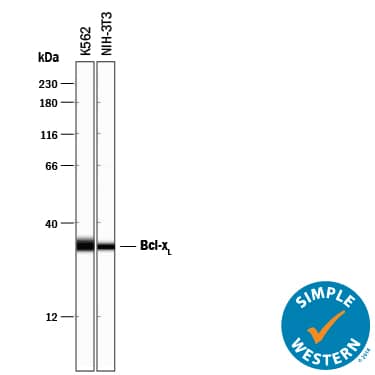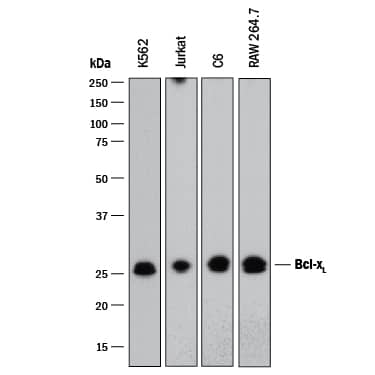Human/Mouse/Rat Bcl-xL Antibody
R&D Systems, part of Bio-Techne | Catalog # MAB894

Key Product Details
Species Reactivity
Validated:
Cited:
Applications
Validated:
Cited:
Label
Antibody Source
Product Specifications
Immunogen
Met1-Arg212
Accession # Q07817
Specificity
Clonality
Host
Isotype
Scientific Data Images for Human/Mouse/Rat Bcl-xL Antibody
Detection of Bcl‑xLby Western Blot.
Western blot shows lysates of K562 human chronic myelogenous leukemia cell line, Jurkat human acute T cell leukemia cell line, C6 rat glioma cell line, and RAW 264.7 mouse monocyte/macrophage cell line. PVDF membrane was probed with 0.5 µg/mL of Rabbit Anti-Human/Mouse/Rat Bcl-xLMonoclonal Antibody (Catalog # MAB894) followed by HRP-conjugated Anti-Rabbit IgG Secondary Antibody (HAF008). A specific band was detected for Bcl-xLat approximately 25 kDa (as indicated). This experiment was conducted under reducing conditions and using Immunoblot Buffer Group 1.Detection of Human Bcl‑xLby Simple WesternTM.
Simple Western lane view shows lysates of K562 human chronic myelogenous leukemia cell line and NIH‑3T3 mouse embryonic fibroblast cell line, loaded at 0.2 mg/mL. A specific band was detected for Bcl‑xLat approximately 33 kDa (as indicated) using 5 µg/mL of Rabbit Anti-Human/Mouse/Rat Bcl‑xLMonoclonal Antibody (Catalog # MAB894) . This experiment was conducted under reducing conditions and using the 12-230 kDa separation system.Detection of Bcl-xL in Human Prostate.
Bcl-xL was detected in immersion fixed paraffin-embedded sections of Human Prostate using Rabbit Anti-Human/Mouse/Rat Bcl-xL Monoclonal Antibody (Catalog # MAB894) at 3 µg/mL for 1 hour at room temperature followed by incubation with the Anti-Rabbit IgG VisUCyte™ HRP Polymer Antibody (Catalog # VC003). Before incubation with the primary antibody, tissue was subjected to heat-induced epitope retrieval using VisUCyte Antigen Retrieval Reagent-Basic (Catalog # VCTS021). Tissue was stained using DAB (brown) and counterstained with hematoxylin (blue). Specific staining was localized to secretetory vesicles in epithelial cells. View our protocol for IHC Staining with VisUCyte HRP Polymer Detection Reagents.Applications for Human/Mouse/Rat Bcl-xL Antibody
Immunohistochemistry
Simple Western
Sample: K562 human chronic myelogenous leukemia cell line and NIH‑3T3 mouse embryonic fibroblast cell line
Western Blot
Sample: K562 human chronic myelogenous leukemia cell line, Jurkat human acute T cell leukemia cell line, C6 rat glioma cell line, and RAW 264.7 mouse monocyte/macrophage cell line
Formulation, Preparation, and Storage
Purification
Reconstitution
Formulation
Shipping
Stability & Storage
- 12 months from date of receipt, -20 to -70 °C as supplied.
- 1 month, 2 to 8 °C under sterile conditions after reconstitution.
- 6 months, -20 to -70 °C under sterile conditions after reconstitution.
Background: Bcl-xL
Bcl-xL is a member of the Bcl-2 family of proteins that regulates outer mitochondrial membrane permeability (1, 2). Bcl-xL is an anti-apoptotic member that prevents release of cytochrome c from the mitochondria intermembrane space into the cytosol. Bcl-xL is present on the outer mitochondrial membrane and is also found on other membranes in some cell types. Natural Bcl-xL contains a carboxyl-terminal mitochondria targeting sequence. Recombinant Bcl-xL missing the mitochondrial targeting sequence maintains its ability to neutralize pro-apoptotic Bcl-2 family members. Neutralization by Bcl-xL appears to be mediated through binding the BH3 region of pro-apoptotic Bcl-2 family members. This activity does not require the mitochondrial targeting sequence.
References
- Gross, A. et al. (1999) Genes and Develop. 13:1899.
- Kroemer, G. (1997) Nature Med. 3:614.
Long Name
Alternate Names
Gene Symbol
UniProt
Additional Bcl-xL Products
Product Documents for Human/Mouse/Rat Bcl-xL Antibody
Product Specific Notices for Human/Mouse/Rat Bcl-xL Antibody
For research use only


